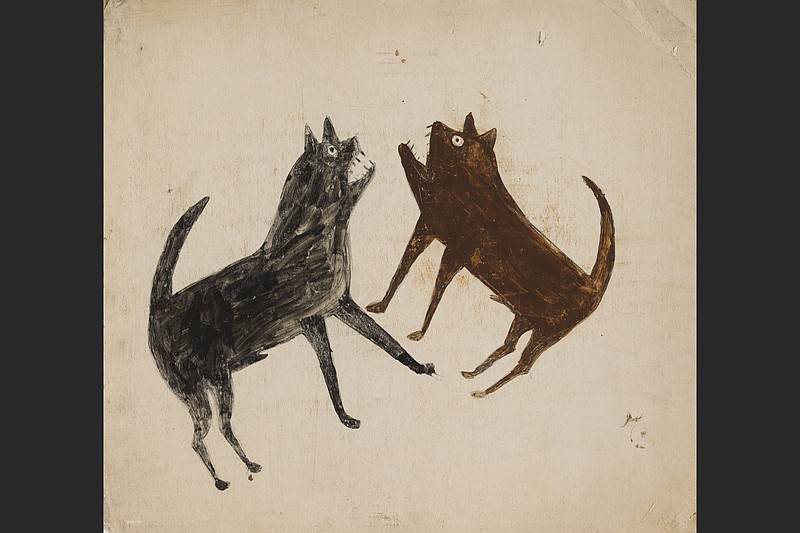In the mid-'70s, punk rock grabbed a toehold in the underground and showed that one didn't need to be particularly adept at one's instrument to make music. Early punk bands in America and England bashed out short, simple songs with passion and naivete, fury and humor. If they were out of tune, so what? If the singer's voice was weird, who cares? All that mattered was they were doing it on their own terms, virtuosity be damned.
Which is not to say that none of those early punks or their descendants wasn't gifted or determined. Many were both, and the music they made transcended the basements and bars and squats where it originated.
It's perhaps overly simplistic, but punk rock has a lot in common with the stunning works on display in "A Visionary Vernacular Road Trip," the current exhibit at the Brad Cushman Gallery in the University of Arkansas at Little Rock's Windgate Center for Art + Design.

The artists shown represent voices that have not always been acknowledged in the art world establishment; they are proof that if the will is strong enough art can come from any and every corner, not just the academy, and some of it will be staggeringly good.
Cushman, the school's gallery director and curator, has gathered a powerful collection of works for an exhibit that winds through back alleys and lesser-traveled paths.
Howard Finster, James "Son" Thomas, Bill Traylor, Jane "in vain" Winkelman, Russell Butler (aka buZ blurr) of Clark County and Minnie Evans are among the more than 40 folk, self-taught and outsider artists from more than 20 states represented in the exhibit, which remains on view through Oct. 24. A reception is set at the center from 5-7 p.m., Oct. 15. Masks are required.
[RELATED: Focus Gallery shows works by Alabama artist]

One of the highlights of the show is the sheer expanse of media used to make these images and objects. Broken glass, scrap paper, leather, tin, house paint, bones, teeth and more show up in the works as proof that art can come from whatever the person creating it has at hand.
"That was enough for me to bring this into the gallery to let students see that if you just let go and explore materials, look what you can come up with," Cushman says. "The reactions that I've seen have been that people really do get pulled in by the mix of media and the lyrical nature of the images."
The works stretch from the 19th century to the present day and include Samuel G. French's elaborately carved walnut and cherry bedstead from the mid 1800s; Clementine Hunter's playful oil paintings depicting her memories of the African House on the Melrose Plantation in Louisiana; the glass and mixed media pieces of Paul Darmafall, aka The Baltimore Glassman; and musician Lonnie Holley's carved sandstone of multiple faces.

To see Bill Traylor's painting, "Fighting Dogs," is a particularly moving experience. Traylor was born a slave in the early 1850s in Alabama. He was in his 80s and living on the streets of Montgomery when he started painting spare, vibrant figures mostly on discarded cardboard and other scraps that recounted memories and observations from his life.
"Fighting Dogs" shows two dogs, one black, one brown, squaring off. They are painted with poster paint and appear in profile, flat on the support, which is actually the back of an old sign (the exhibit's catalog includes a picture of the flip side, an ad for a furniture store). Despite its minimalism, the painting bristles with emotion and energy.
Christianity is a recurring theme. Edgar Tolson's "In the Cool of the Evening" is a wood carving showing Adam and Eve, fig leaves in place, behind a stand of apple trees as God points to the black snake at their feet. "Baptism in front of Buildings with Christ" is a painting by Eddie Lee Kendrick, who was born in Ouachita County in 1928, and shows Jesus with outstretched arms as a baptism takes place.

Howard Finster, the Georgia preacher whose paintings appeared on the covers of albums by R.E.M. and Talking Heads, is represented by a typically text-laden, cleverly designed painting from 1976 called "The Dog's Story of the Bible."
And there are whimsical, sometimes surrealistic works, like Russell Butler's "Tank Head," a mixed media sculpture that uses cardboard, wire, boots, a propane tank, the jawbones of an animal and other found objects to depict a man sitting in a chair; and the futuristic, M.C. Escher-ish "Two Panel Car," intricately drawn in colored pencil by William A. Hall, who spent years living unsheltered in California.
Cushman is a longtime collector of self-taught and outsider artists. Several of the pieces in this exhibit, including Leroy Archuleta's wonderful "Bottle Cap Snake," made from hundreds of bottle caps, and Bessie Harvey's colorful root and mixed media sculpture "Whore of Babylon," are from the collection he shares with his husband, Bobby.

He went back to catalogs from two pivotal exhibits, 1982's "Black Folk Art in America" and "Baked in the Sun: Visionary Images from the South" from 1987, for inspiration for "A Visionary Vernacular Road Trip" and reached out to his network of galleries, collectors and institutions for suggestions and works. The response was such that he decided one show could not contain its breadth, so the exhibit keeps on truckin' for part two, "The Road Trip Continues," at the Windgate Center's Ann Maners and Alex Papas Gallery from Oct. 6-Dec. 2.
‘A Visionary Vernacular Road Trip’
Through Oct. 24, Brad Cushman Gallery, Windgate Center for Art + Design, University of Arkansas Little Rock
‘The Road Trip Continues’
Oct. 6-Dec. 2, Ann Maners and Alex Papas Gallery, Windgate Center for Art + Design, University of Arkansas Little Rock
Hours: 10 a.m.-4 p.m., Monday-Friday, or by appointment (email: becushman@ualr.edu)
Admission: Free
Information: https://www.ualr.ed…">ualr.edu/art | (501) 916-3182; masks required
